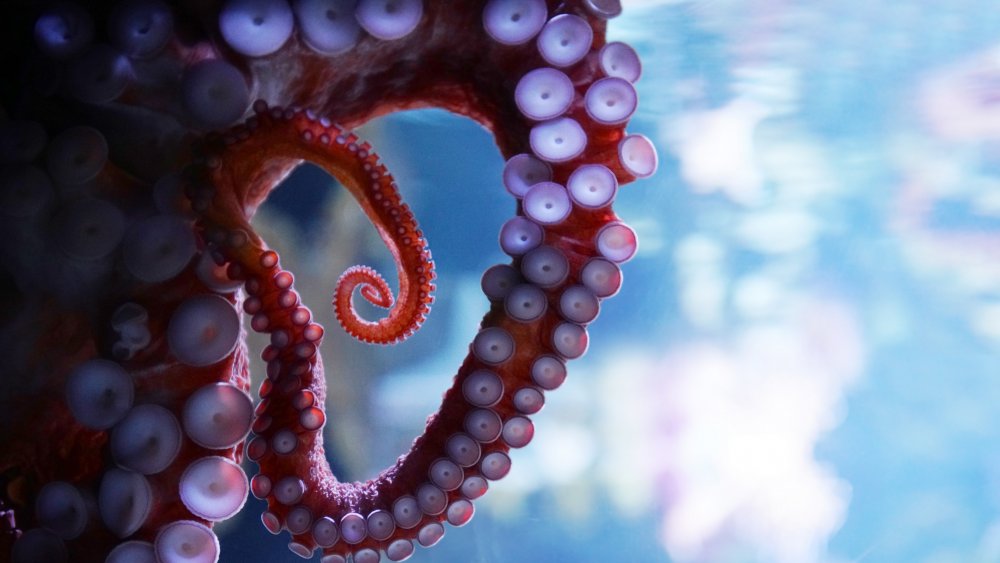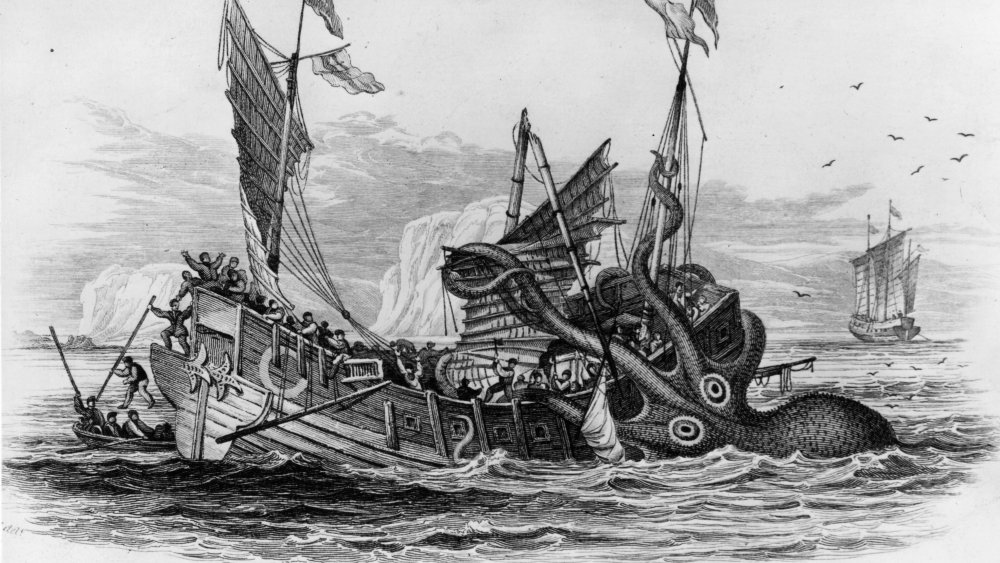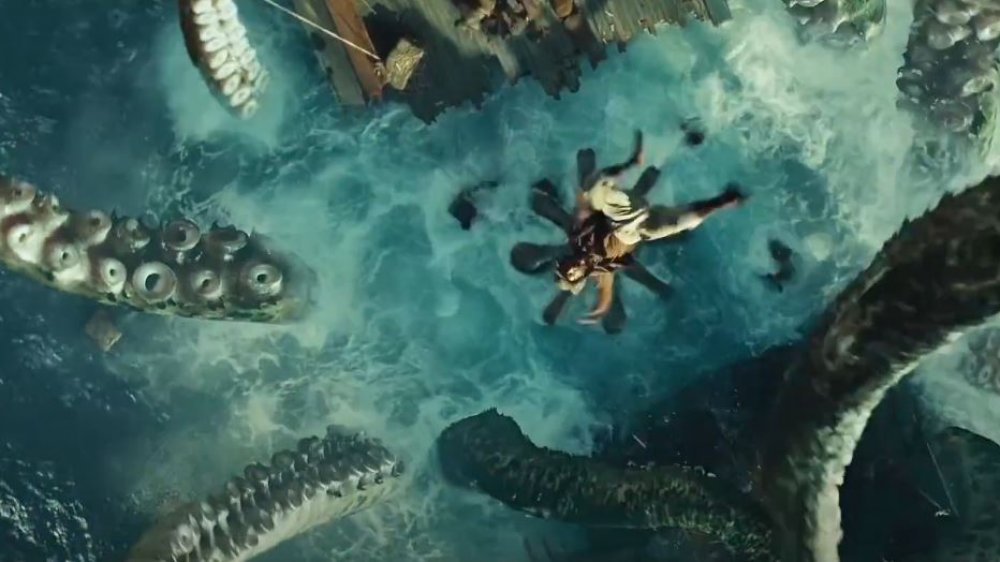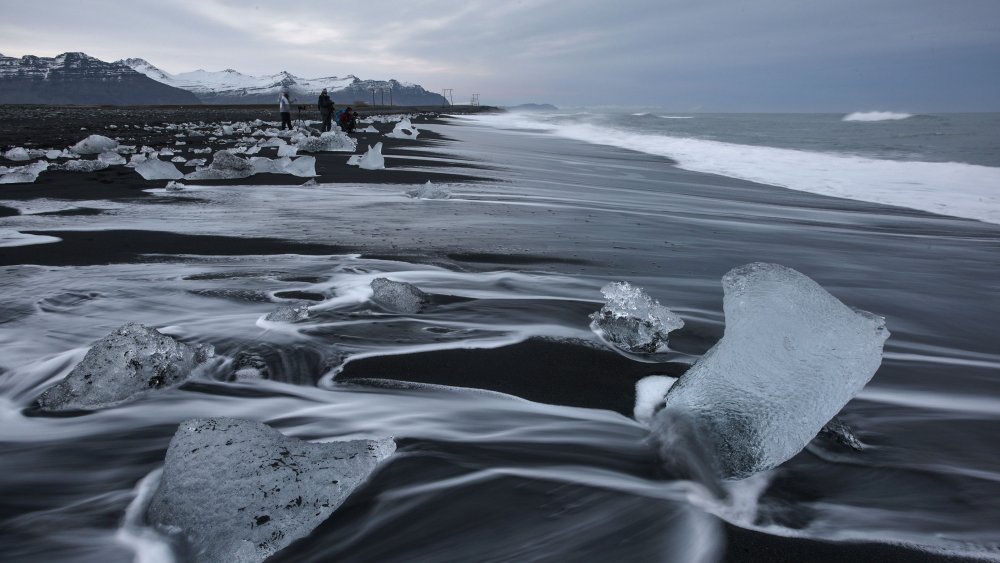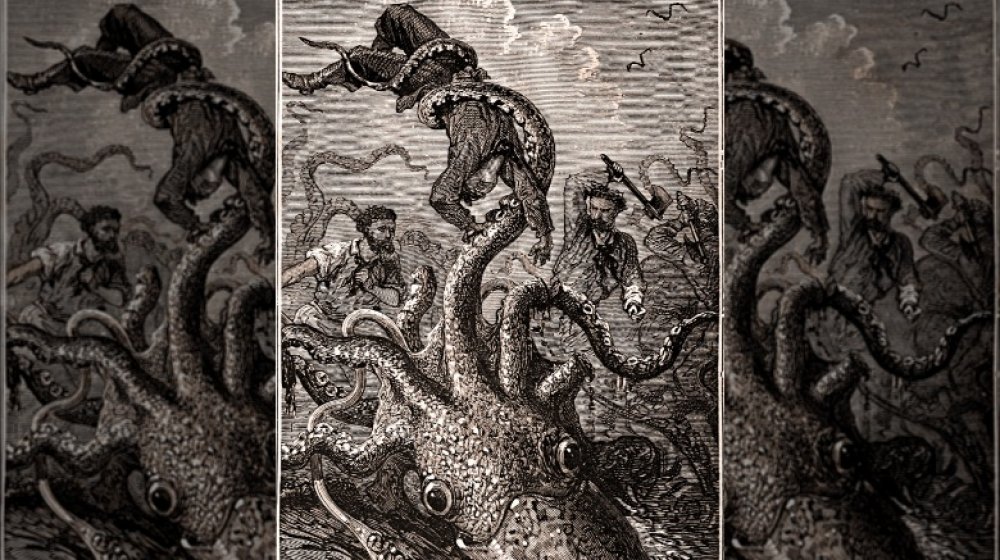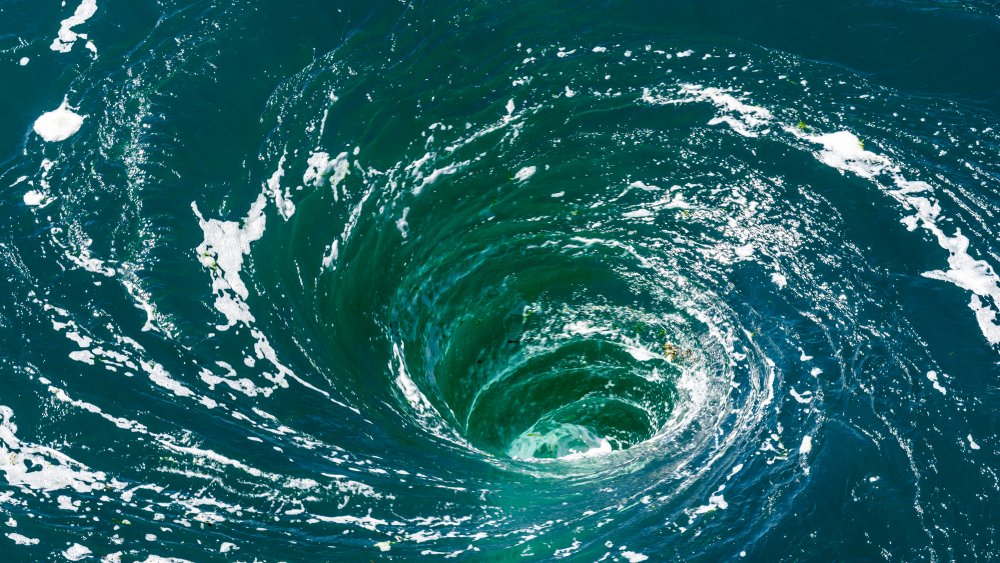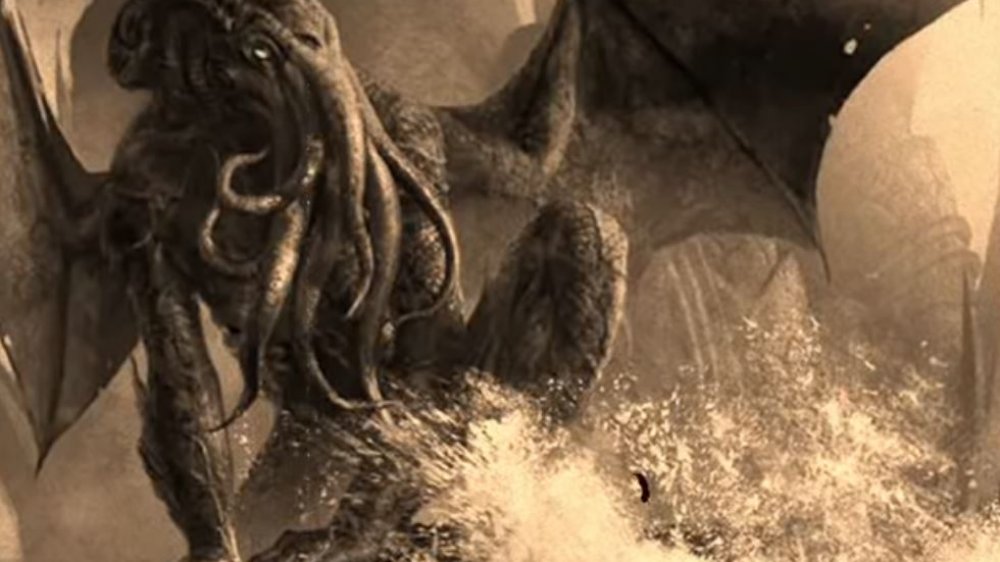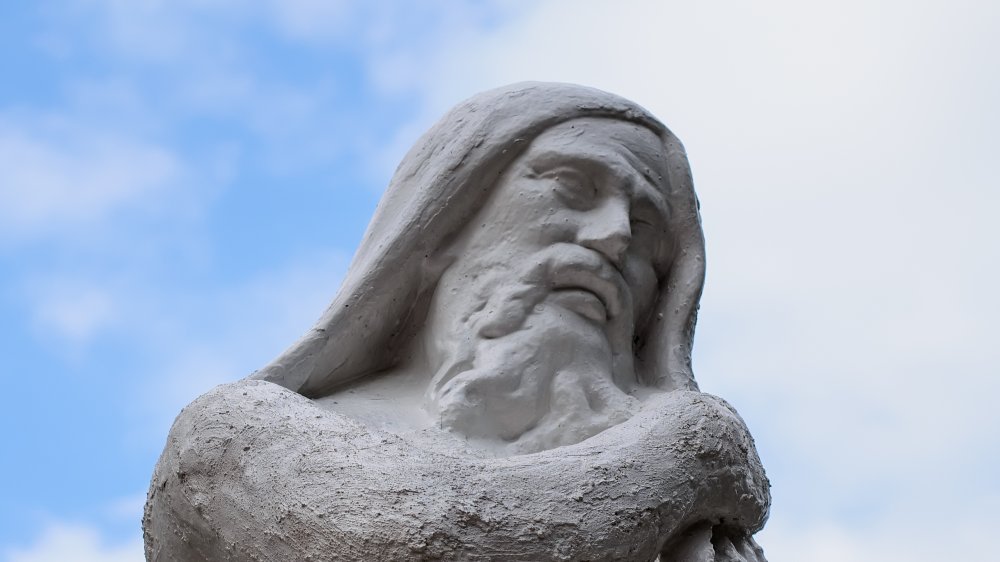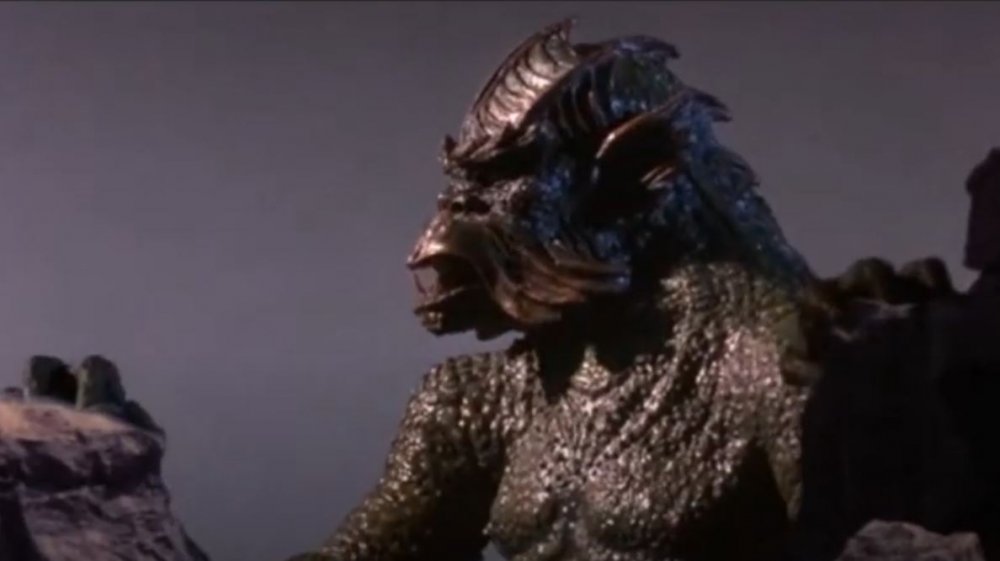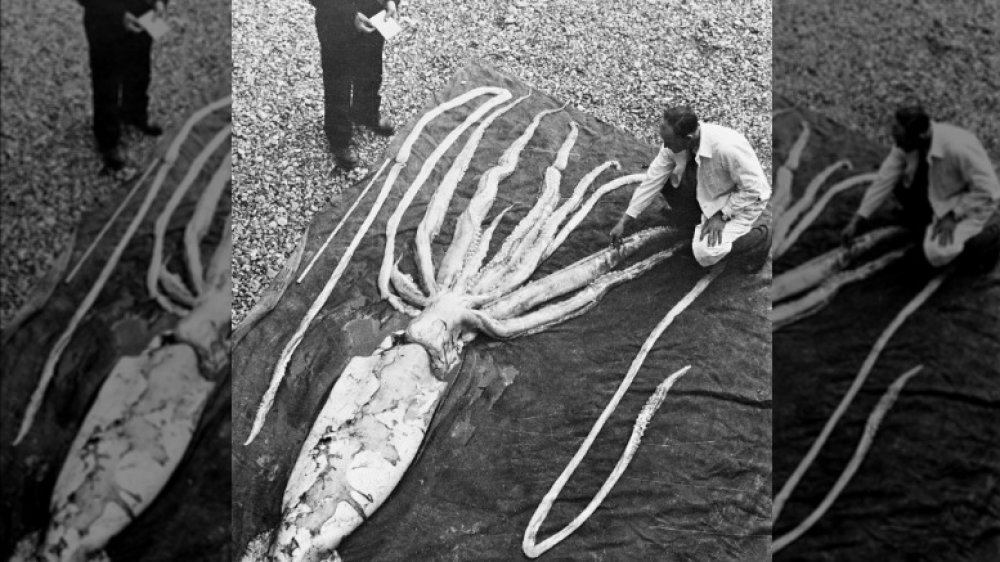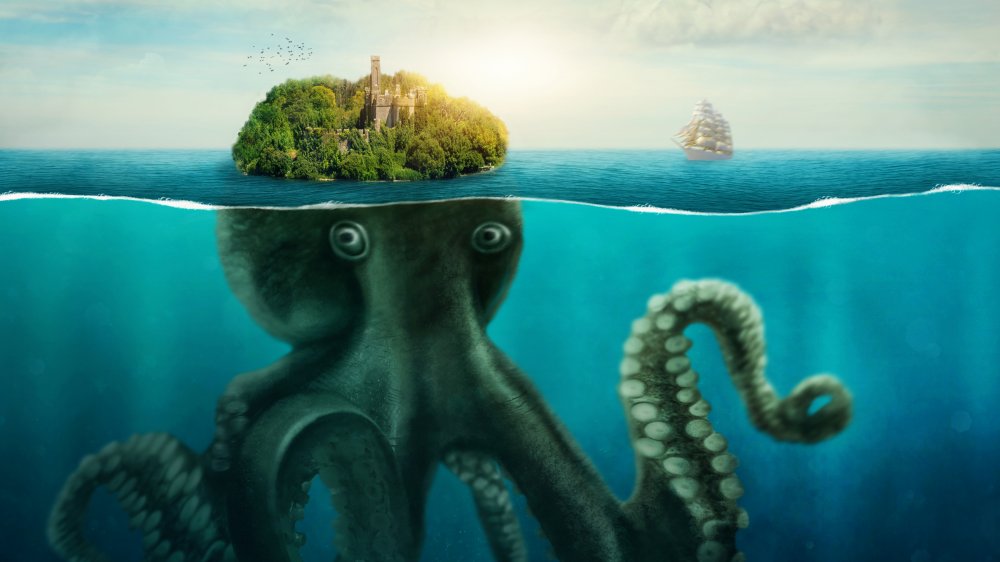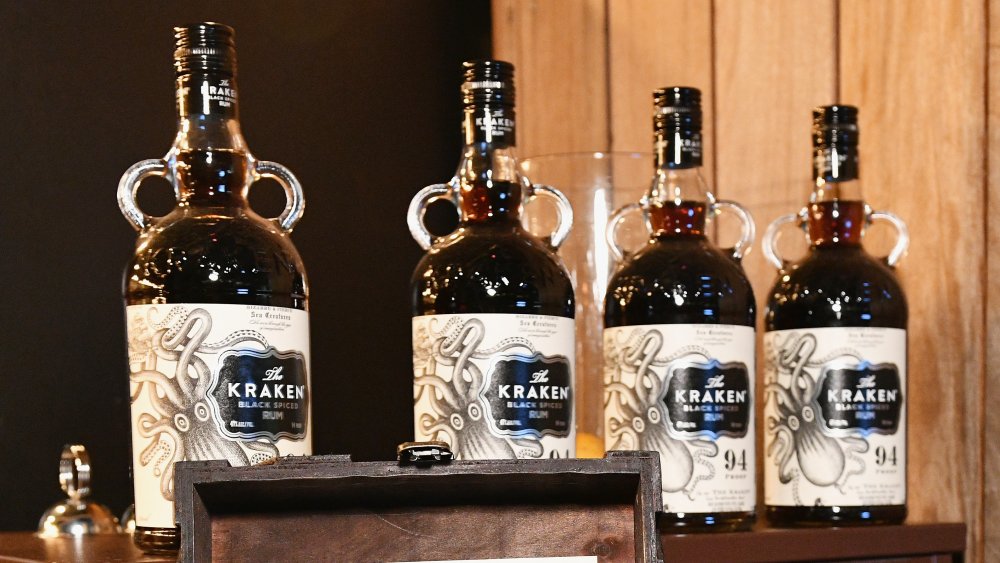The Legend Of The Kraken Explained
If all those crazy myths, legends, and tall tales are to be believed, going out on the open sea is akin to signing away your life. Now, to be fair, the ocean is a dangerous place full of dangerous things, from sharks to hurricanes, but back in the day, sailors spoke of unfathomable entities and creatures that would send even the bravest person scuttling back from the shoreline.
Perhaps the most terrifying sea monster of all, though, was the kraken. Originating from the frightened whispers of Scandinavian seamen, this tentacled monstrosity was believed to be capable of taking down entire boats in its many-armed embrace. Today, the lore of the kraken has entered popular culture, but these stories have evolved quite a bit over the years, and as time has gone on, a logical explanation for this enduring myth has come to be accepted by most historians and scientists. Was the kraken real? Well, dive in, and discover the truth, but don't forget your life jacket.
Wise seamen fear the kraken
Tales of the kraken originated within Nordic culture, as Norse sailors returned to the land allegedly mind-boggled and traumatized by the horrifying sea creature that they had barely escaped. The first documented evidence of the kraken's frightening power dates back to a manuscript from 1180, according to kraken expert Rodrigo B. Salvador, where it was described by Norway's King Sverre as a stupendously large monster, big enough to be confused for an island, which prowled the waters surrounding Iceland.
Stories persisted for centuries. As Salvador wrote for the Conversation, the kraken was accused of wrapping its gargantuan arms around ships and dragging them under, to feast upon the sailors. Though descriptions varied, the creature's island-like size was fairly consistent, as was its M.O., which the historical educational text Konungs skuggsjá described by saying that the kraken — when hungry — gives forth "a violent belch," attracting thousands of fish to the water's surface (alarm bells!), at which point the creature simply swims upward with an open mouth, swallowing anything in its path. If a human ship is in the way? Oops. According to Wired, the other thing sailors watched for, to detect a cracklin' kraken attack, was an odious smell, accompanied by a terrible darkening of the water, said to be caused by either the creature's excrement or belching.
Regardless, once sandbanks and fish start popping up from the water, followed by rising "horns" (AKA tentacles), it's time to skedaddle.
People really were scared of kraken attacks
So, this kraken business was all a big joke, right? Just a way for Norwegian seamen to tease those on the shore, while sharing drinks and laughing at those ignorant landlubbers? Nope. Just like dragons and unicorns, people genuinely feared the kraken, and when you consider that this was an era before cellphone cameras or Wikipedia, that's not surprising. After all, if you encountered some bizarre craziness out on the sea, you'd be scared, too.
It's hard to say just how many kraken encounters genuinely happened, but at least a few tales from survivors must have turned into local gossip, as those who made it back to shore presumably vented about it at the pub, leading to others whispering about it to their friends ... until finally, academics started writing it all down. According to expert Rodrigo B. Salvador, kraken belief grew so widespread that Carl Linnaeus, the legend of biology, even included a description of the creature in the first edition of Systema naturae, though he called it a Microcosmus marinus. Sounds less scary, with that name. Perhaps the most famous description came from Danish writer Erik Pontoppidan, who wrote how local seamen, "unanimously affirm, without the least variation in their accounts," the very real dangers of the kraken. Similarly, according to the 1833 publication of The Naturalist's Library, "The belief in this monster is, however, universal among the sailors and fishermen of Norwegian coast." So, yes, kraken business was serious business indeed.
Finding a kraken does come with some pluses, though
Considering the unreasonable dangers that floating up onto a kraken's backside seemed to possess, you'd think that everyone in their right mind would avoid them at all costs. On the contrary, though, some questionably brave individuals used to actually go out onto the water, gear in hand, and seek out these giant beasts.
Why? No, they weren't monster hunters. They were just fishermen wanting to reap the benefits. See, because the kraken's arrival was believed to draw a truly bonkers number of fish right to the water's surface, via its smelly black emissions, Rodrigo B. Salvador explains that a number of fisherman — I.E., the equally bonkers one — were alleged to have tried to get as close as they could, in the hopes of coming home with a truly impressive catch. It's unclear how many of these thrill seekers were out there, or how successful they were, but the fact that they existed is bizarre enough ... if, admittedly, not the most surprising part of this whole shebang. After all, with any weird phenomenon, there's always somebody who wants to cash in.
Mythology gets messy
It's nice to imagine a streamlined narrative where sailors described a kraken, always called it the same thing, and the creature's overall appearance has been consistent from, oh, the 1100s until today. Like so many mythical creatures, though, the precise details, size, imagery, and even name of the kraken have varied tremendously, with some depictions resembling the original story about as much a banana still resembles a banana after you put it through a blender with chocolate syrup ... or in other words, not really.
Essentially, while the kraken is uniquely ancient — though sea monster myths have always been around, most didn't survive this long — and the stories are relatively consistent, Rodrigo B. Salvador clarified that it wasn't until the 1800s when the kraken was universally accepted as being the cephalopod monstrosity that you know today. While the kraken's immense size has always been part of the mythos, as well as its vicious distaste (or, well, taste) for human ships, its physical appearance used to run the gamut. Some descriptions of the kraken likened it to a lobster-like crustacean. Others described it as a sea serpent, a vaguely humanoid monstrosity, or even just a "misshapen mass," perhaps more Shoggoth than Cthulhu. Similarly, while the name "kraken" is the most common title for the mythical beast, other writers identified it as anything from the super-exciting "Skykraken," to the mundane "Krake," to the bewildering "Crab-Fish." Some, according to the 1833 publication of The Naturalist's Library, called it "Soe-Trolden."
The kraken's infamous vortex effect
Play any video game from the early-to-mid nineties and the boss battles are a doozy. One you've finally blasted away the big guy's health meter, his armor breaks open to reveal a new secondary form, with a brand-new health meter and new attacks. What a dastardly trick!
Well, the kraken was the original boss with a trick up its sleeve. When one of these things tangled its tentacles around your boat and started throwing men overboard, it was horrifying enough. However, in case of the slight chance that you either fought it off — or just said "yeah, right," and took off swimming — the monster would hit you with a surprise twist ... namely, the infamous kraken "vortex." This was basically a way of saying that the tentacled one created a massive whirlpool in the water beneath the boat, though as Rodrigo B. Salvador explains, its approach to doing so depended on how big the kraken in question was said to be. Those who spoke of a more gargantuan animal would claim that the kraken, by simply submerging itself, would sink anything in its wake. Stories of a smaller kraken, on the other hand, insinuate that it rapidly swam in circles around the boat, until the vortex was created. Either way, once the vortex opens, you're a goner.
The kraken's immense impact on literature
Over the years, legends of the kraken have prominently circulated throughout literature, both of the non-fiction and fiction variety, which has in turn inspired more people to write about it — and thus, has kept the mythology going strong. One piece of kraken-inspired text that never stops circulating among the more monster-enthused literati is the 1830 sonnet by Alfred Lord Tennyson, titled (what else?) "The Kraken," which contains stunning lines like the following: "Unnumbered and enormous polypi/Winnow with giant arms the slumbering green." Perfect? For sure. The kraken was also mentioned in Herman Melville's Moby Dick, and probably influenced the depiction of the giant squid in 20,000 Leagues Under the Sea.
One of the kraken's most significant contributions to popular fiction, though, is that it almost certainly inspired H.P. Lovecraft's creation of Cthulhu, a powerful cosmic being, found out at sea, which basically just uses the kraken's tentacled body for the head of its humanoid, bat-winged body. While Cthulhu's mythos is more elaborate than that of the kraken, seeing as the latter is basically just a sea monster with a big appetite, the parallels are impossible not to see.
Inspirations in mythology
Legends grow and change over time. They inspire each other, as one culture builds off the traditions of another, or sometimes just rips off key plot elements entirely. After all, how many religions have a big doomsday flood story, again? Right.
While the kraken is a decidedly Scandinavian monster, Wired has speculated about the other ancient tales and beasts that may have inspired some of the mythology, either directly or indirectly. For example, the common description of the kraken as resembling a land mass mirrors tales of the so-called "island whale" or "whale island," which — while not always a whale — was said to be so huge that sailors would anchor to it, build a fire, and then get dragged under. Big ol' oops, right there. Over in the world of Greek mythology, where Hollywood loves to (wrongfully) place the kraken, there are instead some possible kraken influences in the tentacles of Scylla and the whirlpool-creating abilities of the giant sea monster Charybdis, from The Odyssey.
The kraken in Clash of the Titans ... wasn't the kraken
The kraken's big screen legacy will probably forever be tied to the 1981 fantasy film Clash of the Titans. What's a Norse creature doing in a movie about Greek mythology, you ask? Who knows, because the film's kraken could be called KINO, or "Kraken In Name Only." This Kraken is said to be one of those titular Titans, and depicted as a towering reptilian humanoid, far more Godzilla than Cthulhu. Nonetheless, the stop motion kraken created by the legendary Ray Harryhausen is so magnificent to behold that you can easily forgive the unfaithfulness to the source. Now, as for why the kraken took the place of Cetus, the sea monster from the original Greek legend? According to James J. Clauss of John Hopkins University, the filmmakers were inspired by the Alfred Lord Tennyson poem, and felt that "as a name for a sea monster, it was too good to miss." Fair enough.
When Clash of the Titans came back around for reboot time in 2010, the kraken also returned, though this later film's depiction tried to meet both ends somewhere in the middle: yes, this kraken is a humanoid/reptile Titan, but it also comes with the tentacle action that kraken purists crave. Arguably the reboot's most significant contribution to kraken lore, as the Daily Dot points out, occurs when Liam Neeson's Zeus lets the sea monster loose, proclaiming (wait for it) ... "Release the Kraken!"
The closest thing to a real kraken? Giant squids
These days, the world has largely accepted that tales of the kraken, while exaggerated, were probably based on very real (and very frightening) ancient encounters with giant squids. And sure, while these animals definitely aren't the size of islands and probably don't eat humans, it's easy to see why encountering a tentacled creature over 40 feet long, on a dark night, could certainly cause your imagination to do some embellishment.
Much like the kraken of legend, giant squids are still one of the most mysterious animals on Earth. It took all the way until 2013 for a live giant squid to even be captured on film, according to NPR — note, the headline was "The Kraken is Real" — and as Business Insider reports, these creatures are so elusive that almost everything scientists know about them today comes from the occasional corpse that washes up. Regardless, the discovery of giant squids, about 150 years ago, has made it clear that Norse seamen weren't just making stuff up. Even the oft-reported way that the kraken's arrival would be foreshadowed by a "darkening of the waters" (allegedly from its excrement) can, as Wired points out, be explained by a giant squid's inking mechanism.
So yes, the kraken is real, and presumably, that means some unfortunate fishermen in olden times were genuinely unlucky enough to find a real giant squid tangling up their boat in its many, many arms. Good luck sleeping at night.
Why so violent, Mr. Sea Monster?
Okay, so why was the kraken such a vicious beast? Was there a curse of some sort, which perhaps once transformed a sailor into a terrible monster? Given that this is Norse mythology, maybe it has something to do with Loki? Nah. According to expert Rodrigo B. Salvador, people generally believed the kraken was just a big animal that liked eating human flesh. What about actual giant squids, though? Once you've accepted the fact that these real-life animals presumably inspired kraken myths, you then have to contend with the notion that your next boating trip might involve a cephalopod attack. Maybe. Or maybe not?
Frankly, giant squids aren't generally known for attacking boats, considering they rarely emerge in the first place. That said, reports of squid aggression are (occasionally) made, though hard to verify. In the aftermath of World War II, according to National Geographic, a group of shipwrecked sailors claimed to have been attacked by a giant squid, even stating that the animal devoured one of their companions. In 2003, then, French yachtsman claimed that a giant squid clung onto their boat. Similarly, according to the Guardian, there have been many descriptions of the Humboldt squid, nicknamed the "red devils," as being prone to aggression, though this later breed of squid is not quite as large as its giant cousin, as they only tend to grow about six feet long. Not that a hostile, human-sized squid is particularly less scary than a giant one, but hey.
The Kraken of Tacoma, and other such legends
Whether through cultural assimilation of the kraken myth, or simply the nightmarish imagery associated with being pulled underwater by a blast of spongy tentacles, tales of the kraken have endured ... and kraken-type myths persist to this day, even if they're a bit less fantastical than the tales of olden times.
One notable example? If you take a trip to Washington state, you might hear about (and hopefully not come across) a local celebrity, the so-called "Kraken of Tacoma," who more commonly goes by the name King Octopus. According to Culture Trip, King Octopus is said to weigh about 600 pounds, and allegedly lives underneath the giant Tacoma Narrows Bridge. No proof of King Octopus exists, but you know, witnesses gonna witness. One Tacoma local reported to KUOW that he even saw the big fella's tentacle rise 15 feet out of the air at night, which is definite horror movie material. Meanwhile, if you go quite far down the road to Oklahoma, Animal Planet reports that there are tales of a kraken-like animal called the Oklahoma Octopus, said to be about the size of a horse. Again, no proof, but similar such stories can be found all over the world.
Legacy of the kraken
These days, kraken imagery is tied almost exclusively to giant squids, to the point where it isn't uncommon to simply see the real animals referred to as the kraken. A quick Google search for "kraken" will bring up loads of giant squid images and headlines, and in a way, this is a nice form of vindication for the mythical beast: if anyone in the 1800s ever doubted those sailors, oh boy, they're hearing about it now. Or not, because they died a long time ago, but you get the idea.
Clash of the Titans aside, the kraken's tentacles have only gotten more and more tangled into popular culture. To date, the kraken's most impressive (and accurate) film appearance was probably an epic take-down scene in Pirates of the Caribbean: Dead Man's Chest, though the creature has also appeared in goofy B-movies like 2006's Kraken: Tentacles of the Deep. There is a Kraken roller coaster at SeaWorld, and since 2011, Kraken has also lent its name to a form of cryptocurrency, for those who thought Dogecoin wasn't cool enough. Meanwhile, if you wanted to inject some tentacles into your next party, there are a number of kraken-themed beers out there, and your next Halloween party would be ideally served by some Kraken Black Spiced Rum, the liquor with the most badass label of all-time. So the real kraken might not sink ships, but if you drink enough Kraken rum, it'll definitely sink you.
